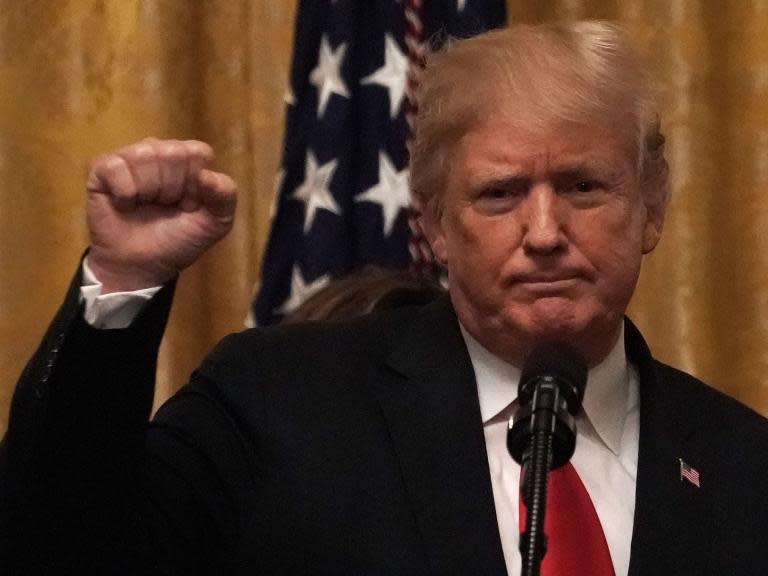Donald Trump thinks it’s his fault that Iran’s currency is in meltdown. He shouldn’t be so arrogant
Since the beginning of this year the Iranian rial has, as economists say, "gone through the floor" – the currency has depreciated by nearly 70 percent against its benchmark. Most observers have described this as the effect of rising tensions in US-Iran relations, particularly the US’s withdrawal from the landmark 2015 Iran nuclear deal, known as the Joint Comprehensive Plan of Action. And in a surprising admission for Iranian politics, even Iran’s president, Hassan Rouhani, laid the blame for his country’s currency woes squarely at Donald Trump’s door during a recent parliamentary session (while also attempting to implicate his internal opponents).
Somewhat ironically, this is perhaps the only issue on which Trump and Rouhani can find themselves in agreement. Trump, seconded by National Security Adviser John Bolton, has been more than happy to take full credit for the chaos in Iran, implying that his sanctions have left the Islamic Republic with little breathing space.
But some beg to differ, not least Rouhani’s own central banker, the newly appointed Abd al-Naser Hemmati. Speaking at a conference on 1 September, he went on the record as saying that the real reason behind the rapid depreciation of the rial is the untethered growth of Iran’s money supply.
Hemmati’s observation is a truism that has largely been absent from discussions of the present crisis. Iran’s money supply has nearly tripled since Rouhani took office in 2013, reaching the astronomical amount of 16 quadrillion rials by the end of August. Increasing the money supply as a cheap, short-term solution for successive governments’ internal debt and deficit problems is a pedigreed tradition in post-revolutionary Iran, with monetary policy playing the role of a check on the inflation rate. But, after several shady banking businesses and credit institutions going bust in the last couple of years, confidence in the banking sector has all but eroded, rendering the textbook option of raising interest rates to control the amount of liquidity ineffectual.
This also explains why the current panic has not remained limited to the country’s foreign exchange market, and has spread to the gold and automotive markets as well. What is more, the bite of US sanctions has yet to be felt, and, at least for the first three months of the crisis, there is no evidence of the government – the main supplier of foreign currency in Iran’s hermetically sealed economy – slashing its injection into the market.
So what has triggered the rial’s downward spiral? Is Rouhani right in asserting that the timing of the protests and the rial’s crash are not coincidental? While it is impossible to know for sure, another factor is likely to have played a larger, and far more insidious, role: the looming crisis in the emerging markets, set off by the run on the Turkish lira.
Turkey and such emerging markets as China, India, and South Korea constitute the main destinations for foreign-bound Iranian commodities, mainly oil and gas, accounting for 65 percent of the country’s $92bn exports in 2017. Most of the exports to these countries is paid for in their national currencies, thus saturating the Iranian ForEx market with emerging market currencies. This makes Iran’s foreign exchange market very sensitive to any volatility in the emerging markets, particularly in those parts where Iran has a strong trading presence.
The Turkish crisis and evaporation of confidence in the lira and similar currencies, such as the Indian rupee, seem to have pushed arbitrage in Iran’s currency market towards benchmark currencies – chiefly the sterling, euro, and dollar – creating a spike in demand. This is clearly borne out by the broad correlation between the fluctuations in the respective exchange rates of the lira and rial against the US dollar since early 2018.
One other factor that has to be counted in is Tehran’s near-lack of access to the international financial system, which has made the country ever more reliant on Turkish banks and financial actors for international transactions, resulting in its even more vulnerability to contagion during times of distress in Turkey. Add to all of this Iran’s banking sector plight and liquidity growth, and you end up with a perfect recipe for a currency meltdown.
The assertion that Iran’s current economic malaise has the name Donald Trump inscribed all over it is an oversimplification with one clear aim in sight: buoying the sinking popularity of Trump and Rouhani both.
But as politicians in Washington and Tehran peddle non-facts for short-term political gains, two concurrent crises rage on: one besetting Iran’s troubled economy, the other the US’s slapdash foreign policy.
Mehdy Shaddel is a historian of the late antique Middle East. Follow him on Twitter: @MayShaddel

 Yahoo News
Yahoo News 

